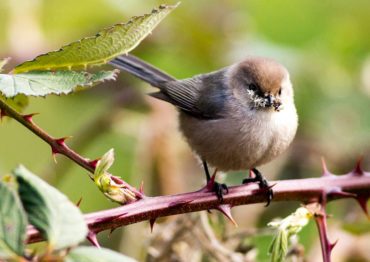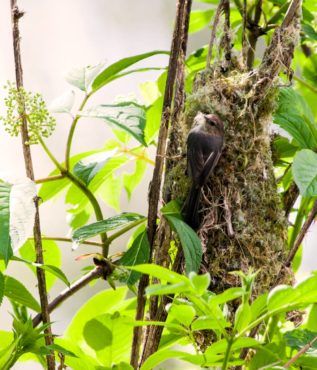
Small songbirds are easy to overlook. Most people will notice a bald eagle on a pole but will miss a little gray bird in a nearby shrub.
In the world of birds, the largest ones will always make a lasting impression. Someone seeing a brown pelican for the first time may think it’s huge. That is, until that same individual sees an enormous American white pelican and realizes its smaller cousin isn’t so huge after all.
Birders are just as thrilled by the little guys as they are by the big ones. For instance, northern saw-whet owls are favorites among owl lovers because of their endearing diminutive size.
The same affection is shown for a tiny songbird called a bushtit. From head to tail, the bushtit measures less than 4 inches long and breaks the scale at no more than 6 grams (about 0.2 ounces). The only birds in West Sound that are smaller than bushtits are the Anna’s and rufous hummingbirds.
Simply stated, the bushtit looks like a tiny gray ball of fluff with a long tail and short, black bill. The forehead has a brown tint to it. Females have pale eyes and males have dark eyes.
Bushtits are year-round residents of Western Washington, Oregon and the Southwest. One of the world’s smallest songbirds, they are dwarfed by larger species of hummingbirds in the Southwest.
Bushtits are found in a variety of habitats, including deciduous and evergreen forests, riparian areas and scrubland, as well as suburban backyards and parks. They sometimes visit suet feeders, providing an entertaining spectacle, as a large flock can cover every square inch of a suet cage. In frigid weather, bushtits stay warm by huddling close together to reduce heat loss.
The energetic bushtit is constantly in motion while foraging for spiders, insects and other small invertebrates in trees and shrubs. Often travelling in flocks of one to three dozen birds, individual bushtits stay in constant contact with each other through a series of “psht” calls. Alert birders locate bushtits by pinpointing the source of this chatter.
Bushtits are very agile as they flit about through the vegetation, often hanging upside down to glean the underside of a branch or leaf. If necessary, they can even hold on with one foot. But bushtits are weak flyers, usually taking only short, fluttery flights from tree to tree. Instead of flying at once, a flock will typically depart one bird at a time for the next tree or shrub.
Sometimes bushtits are outmatched by the size of their prey. A caterpillar may be too strong for the pint-sized predator to pry loose from a branch. The dejected bushtit is then forced to abandon the juicy meal in favor of something more manageable.
As spring draws near, winter flocks begin to separate into nesting pairs. By winter’s end, pairs are selecting the best spot for their nest, which may be located anywhere between one and 30 meters off the ground in a tree or shrub.

Bushtits are most famous for their incredible nests. The carefully crafted bushtit nest is a marvel of engineering and a unique work of art. One may expect a tiny bird to build a tiny nest, but that’s not the bushtit way.
In late winter, the pair works together to search out a perfect location for their nest. They test multiple sites by attaching spider silk to branches to determine which one is to their liking. Once the appropriate nest spot is selected, the monthlong construction process begins.
The unmistakable bushtit nest is a hanging foot-long, sock-like structure with an entrance hole near the top. Anchored to its supports by spider silk, the nest is a masterfully woven combination of moss, lichen, spider silk and other plant material.
As the nest is being built, one of the bushtits sits in the partially constructed nest to stretch it downward. The female shapes the nest chamber at the base of the nest and lines it with feathers and fur for insulation, while the male continues to add material to the exterior. Repairs and reinforcement to the nest continue into the incubation period.
Bushtits lay four to 10 eggs and both parents take turns incubating them for 11-13 days. After 18 days, the young are ready to leave the nest. Mated pairs usually raise two broods per year.
Bachelor bushtits, called helpers, may sometimes assist the pair with parenting duties. The nest is large enough that the parents, nestlings and a couple of adult male helpers may all sleep inside.
Bushtit populations appear to be stable, but the use of pesticides and elimination of native vegetation will force them to search elsewhere for their meals.
The saying “big things come in small packages” is reversed for the pint-sized bushtit. This small bird from a big nest should not be overlooked.



























